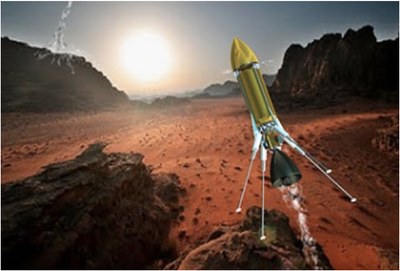ISRU rocket hopper: an idea whose time has come?by Eric Shear
|
| A hopper would be able to fuel itself from the Martian atmosphere and travel greater distances much more quickly than a rover while ignoring obstacles. |
In-situ resource utilization (ISRU) is such a concept. On Mars, possible near-term ISRU avenues range from producing methane from atmospheric carbon dioxide via the Sabatier reaction, splitting said carbon dioxide into carbon monoxide and oxygen, or just burning the carbon dioxide with magnesium powder in a rocket engine. These approaches have their pros and cons. Nevertheless, what they all have in common is the ability to gather carbon dioxide from the atmosphere for processing, which itself is not a difficult technical task. It is the processing part itself that promises the greater challenge.
A review of the relevant technical literature seems to conclude that some ISRU-derived propellants are better (more energetic, easier to store) than others, and that the more energetic the propellant is, the longer and more complex the ISRU process tends to be. It might also be possible to use Martian water as a hydrogen source for the process instead of importing super-cold liquid hydrogen from Earth with its attendant technical difficulties. The designers of a near-term ISRU mission would have to justify the technical complexity of the ISRU process with the benefits that it would bring.
The Mars Program Planning Group (MPPG) reviewed over 400 proposals in 2012 with the goal of continuing NASA’s highly successful Mars Exploration Program. Some of the proposals included ISRU in their designs, such as “rocket hoppers” propelled by heated carbon dioxide or by carbon monoxide/oxygen combustion. Such a vehicle would be able to fuel itself from the Martian atmosphere and travel greater distances much more quickly than a rover while ignoring obstacles. This is invaluable not just because it makes a greater variety of locations accessible; it makes imaging of wide swaths of the ground possible at higher resolutions than what orbiters could achieve. It thus bridges the difference in capabilities between rovers and orbiters.
There were also proposals for multiple small rovers to be fielded in a single mission. While the development cost for each rover would be lower than it was for Spirit and Opportunity, the logistics of running each rover at the same time (more drivers, increased time on the Deep Space Network) make these proposals impractical with current technology. An ISRU rocket hopper promises to cover much more ground and multiple heights of the atmosphere while testing out ISRU hardware for human missions, all without increasing the personnel and antenna requirements. A balloon vehicle would have similar imaging capabilities, but not the payload, lifespan, or controllability of a hopper.
The concept originated with Dr. Robert Zubrin. His company, Pioneer Astronautics, has already tested out carbon dioxide acquisition methods and carbon dioxide thermal rocketry. Dr. Geoffrey Landis has investigated the possibility of using rockets burning carbon monoxide with oxygen, with favorable results. These propellants are not as energetic as hydrocarbon fuels, but they can be obtained on Mars without the use of liquid hydrogen. This allows the vehicle to hop an unlimited number of times. Heated carbon dioxide is technically easier to accomplish, but carbon monoxide/oxygen combustion offers more range and a bigger payload.
An ISRU rocket hopper might be just the right thing for a precursor mission before humans are sent to Mars. A return trip would require large quantities of methane and oxygen rocket bipropellant to be manufactured on site. With a predominantly carbon dioxide atmosphere, the availability of hydrogen will be the limiting factor in methane production. A human mission would benefit from the presence of Martian water on site as a primary or backup hydrogen source.
| An ISRU rocket hopper might be just the right thing for a precursor mission before humans are sent to Mars. |
While the Mars Odyssey orbiter has detected concentrations of hydrogen above 8% by volume in the surface with its gamma-ray spectrometer, that instrument has a spot size of 200 kilometers and does not differentiate between ice and hydrated minerals. In order to take advantage of subsurface hydrogen for ISRU, the exact nature of that hydrogen needs to be defined in both spatial scale and form. This can only be done by using the gamma spectrometer at altitudes much lower than orbit, and by complementing it with ground-penetrating radar and a visible camera. Other measurements can be done at these altitudes, such as local magnetism and atmospheric dust content.
It is for these reasons that the ISRU rocket hopper may be an idea which time has come. The hopper can carry a science payload to balloon-like altitudes and without the balloon’s short lifespan and limited payload capability. It has the potential to bridge the gap between rovers and orbiters, which is something that is sorely needed in Mars mission planning.
